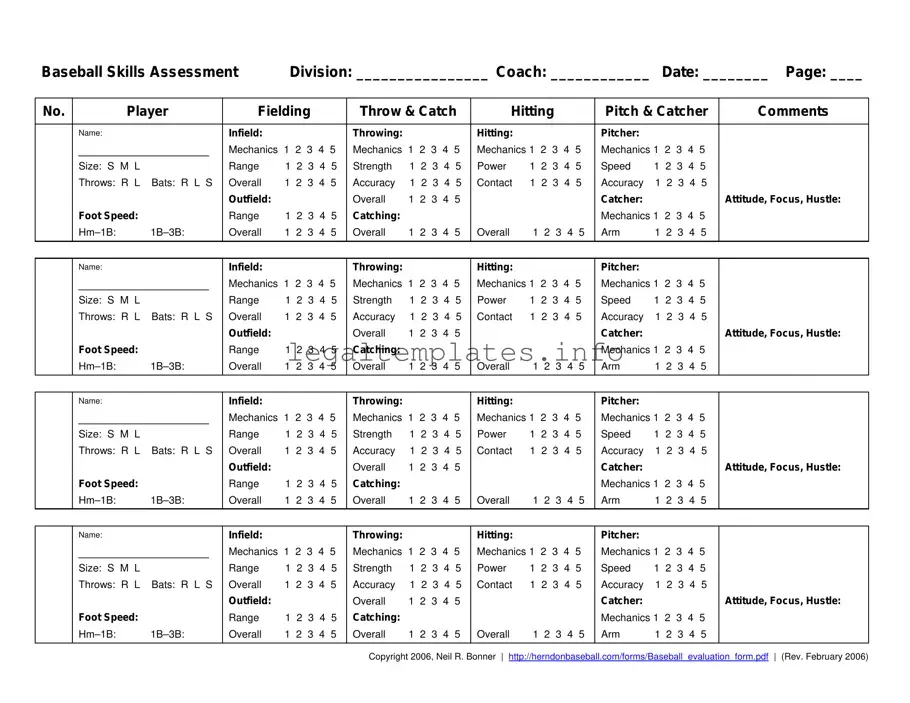What is the purpose of the Baseball Skills Assessment form?
The Baseball Skills Assessment form is designed to evaluate the skills of players in a standardized and comprehensive manner. It is primarily used during tryouts for All-Star travel teams and can also be employed for drafting players within "house" leagues. This form allows coaches to score players across various skill categories—fielding, throwing, hitting, pitching, and catching—on a scale from one to five, based on their performance relative to their peers. This structured evaluation ensures a fair and objective selection process for team composition.
How are players scored using the Baseball Skills Assessment form?
Players are scored across multiple skills, including fielding, throwing, hitting, pitching, and catching. Each skill is scored on a five-point scale, with five representing exceptional ability and one representing poor ability. Scores between two, three, and four indicate varying levels of skill in between the extremes. This scoring system helps to quantify a player's abilities in a clear and concise manner. Furthermore, additional points may be added or deducted based on a player's speed, attitude, focus, hustle, and specific contributions to pitching or catching.
What is the role of quantitative scores in the All-Star selection process?
Quantitative scores play a critical role in the All-Star selection process by providing an objective basis for choosing the first eight players on the team. These scores help to ensure fairness by allowing evaluators to make selections based on measurable skill levels. After the initial eight players are selected based on these scores, the All-Star manager has the discretion to choose the remaining team members using any criteria deemed appropriate, which allows for a balanced and well-rounded team composition.
How should coaches weight the different skill categories?
While the distribution of importance among skill categories may vary, a suggested balanced approach includes weighting overall scores in defensive categories (infield, outfield, throwing, catching) for a maximum of 20 points, and counting mechanics, power, and contact for hitting for up to 15 points. Additionally, speed assessments during base running may result in added or deducted points. Importantly, coaches have the flexibility to adjust points for pitching or catching skills and to factor in a player's attitude, focus, and hustle, tailoring the evaluation to reflect the needs and values of the team.
Can the Baseball Skills Assessment form be adjusted for different league requirements?
Yes, the form is designed with flexibility in mind, permitting adjustments to suit various league requirements and preferences. Coaches and evaluators can modify the scoring system, add or omit assessment categories, and adjust the emphasis placed on different skills to best fit the needs of their specific league or team. This adaptability ensures the form remains a valuable tool for a wide range of baseball programs.
What is the format of tryouts as suggested alongside the Baseball Skills Assessment form?
The tryouts are structured to cover a range of activities including warm-ups, base running, infield and outfield skills, and hitting, with specific durations allotted to each segment. The structured format ensures a thorough evaluation of each player's abilities across all necessary skill sets. Additionally, there's a provision for evaluating pitchers and catchers separately, underscoring the importance of these roles. This comprehensive approach allows for a detailed and efficient assessment process within a timeframe of approximately 2 to 2.5 hours.
How should the results of the Baseball Skills Assessment be communicated to players?
After the tryouts, it's important for the management to communicate the results to players in a manner that is both respectful and constructive. Typically, a meeting or a written communication will be organized to inform players of the decisions made. It is essential to offer feedback that helps all players understand their performance, with an emphasis on encouraging continued development and enjoyment of the game, regardless of the outcome. For those who made the team, specific instructions and expectations going forward should be clearly laid out, while providing resources or guidance for those not selected can help maintain their enthusiasm and commitment to improving their skills.

